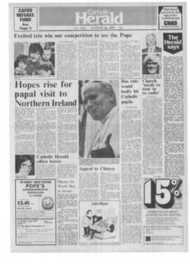Page 7, 24th August 1979
Page 7

Report an error
Noticed an error on this page?If you've noticed an error in this article please click here to report it.
Tags
Share
Related articles
Call To Save England's Most Famous Catholic Home
Stonor, Chapel To Be Restored
This Age-old Altar Has Never Lost The Mass
The Hidden Stream
Historic Houses
Stonor an ancient Catholic home
IF STONOR had been put in a novel. no one would believe it could exist, But there it is, digging its heels into the Chilterns, so that when you go in the front door and up the stairs you can walk out on to the grass again at the back. The house seems to grow out of the landscape, and indeed the clay for its bricks was carved front a nearby valley.
As well as being the ideal of an English country house. Stonor is practically a place of pilgrimage for Catholics. Mass has been celebrated in the chapel since the twelth century, without a break at the reformation. More than just a priest's hole, it has a hiding place behind the chimneys where Ectmund Campion printed his "Ten Reasons for being a Catholic", which hastened his arrest and martyrdom.
The Stonor family held on to the Faith with such risk and loss that it is surprising the line survived at all. The recusancy fines for not going to the Church of England on Sundays ran into thousands of pounds a year, and this went on for over a century while estates were sold off. 'they kept on harbouring priests, for which the penalty was death. They were barred from public positions and had to send their children overseas to be educated. On top of this, members of the family entered the priesthood or religious life, which cut down chances for the succession.
The family picked up the ancient Camoys barony in the nineteenth century and in the twentieth settled down into being administrators and justices of the peace. The latest crisis came when the present Lord Camoys's father shut up the house, auctioned the furniture and it looked like the family would be parted from it for ever. It has taken all the skill and energy of Thomas Stonor, seventh Lord Camoys, to put the place back on its feet since the title came to him three years ago.
So now, when the visitor pays his pence, he can see the family portraits on well-painted and papered walls, and the library of rare Catholic books, printed in penal times, where it should he, in the fourteenth century barrel vaulted room which was called the solar in the middle ages, a good old word for a warm upper room.
The very English thing about the house is its unpretentiousness. Certainly it is large, but it has none or the dwarfing qualities 01 Blenheim or Chatsworth. It was built to live in, not to impress. It was never the work of an architect, but grew up. unplanned and irregular. And it started early — the valley of Stonor was first
mentioned in a document from 700 AD, when the Venerable Bede was a young man.
As a result it is a jumble of wings and gables in every style. The Georgians gave it regular sash windows on its frontage, but could not help there being eight on one side of the doorway and seven on the other. Lord Carnoys' study has corinthian pillars in the style of Adam. While the pillars of the thirteenth century hall peep out of the wall on one side of the house, on the other the eighteenth century fans of neo-Gothic had installed pointed arches and windows.
A statue of our Lady of Mercy was put on the South front, guarding the door, at the beginning of the reformation when it seemed the family might lose the house. It stands there still, like Stor.or itself a survivor of violent change when so much Catholic culture was destroyed.
Stonor is open April to September, Wednesdays, Thursdays, Sundays and Bank Holidays (not Good Friday). 2-5.30 pm. Adults 90p, children 40p.
blog comments powered by Disqus











